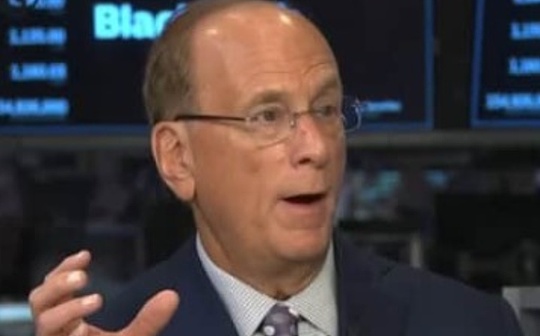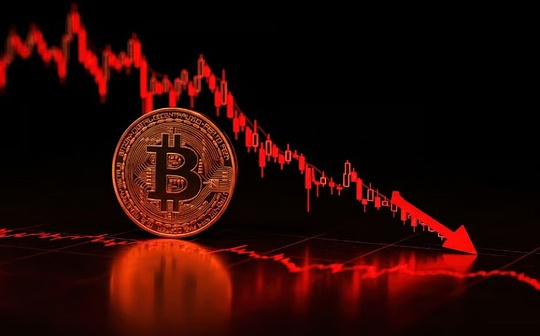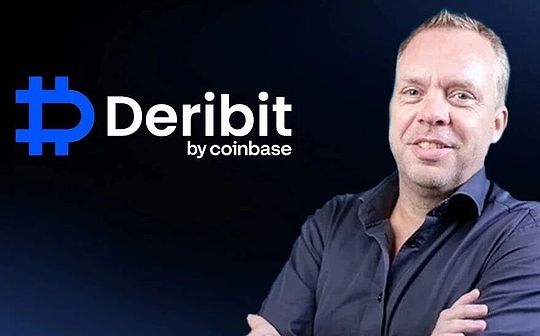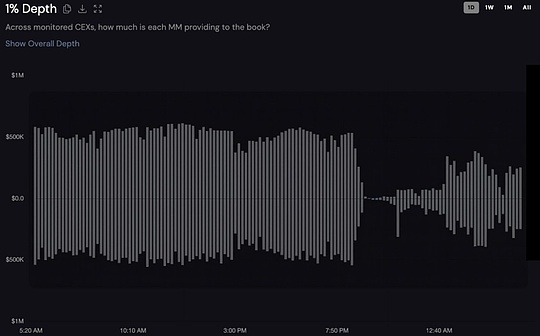
Author: BroLeon, the big lion brother of Tu’ao; Source: X, @BroLeonAus
I saw a lot of KOL tweets today and some people are still asking why many copycats were able to insert their pins to a position close to zero on the night of the collapse.I had similar doubts before, until I later figured out how MM works in CEX.
@yq_acc’s post specifically talks about the behavior and logic of market makers on the night of the crash. It is worth reading for friends who have the patience to figure out the operating mechanism.But today I will briefly explain the common misunderstandings and questions about MM based on the situation on 1011. If my explanation is wrong, market makers are welcome to comment.
Who usually provides liquidity in CEX?
The centralized exchange CEX actually just provides a platform (casino), on which the active roles all year round are not only project parties (various gambling tables), traders and users (gamblers), but also various market makers (Market Maker, hereinafter referred to as MM) that provide liquidity.Of course, MM is not the only one that actually provides liquidity. Project parties sometimes also provide initial liquidity on CEX, especially when new coins are listed.The accumulation of limit-price buy and sell orders placed by retail investors themselves also contributes to “market depth.” However, compared with professional market makers, retail investors’ liquidity is more “fragile”
Why does this role exist?
The purpose of MM is to allow every gambling table to place orders at any time, so that gamblers will not have no opponents when they want to gamble in the past. In layman’s terms, it is like lubricant. Without them, the market will be very “dry”.Without a market maker, buyers and sellers need to be matched directly, which will result in huge transaction price differences, and small transactions can also cause large fluctuations.
If you go to CEX and try to place orders on both large coins and particularly unpopular small coins, you will feel that there is almost no fluctuation in large funds entering and exiting casually on large coins, while small coins may cause a 20% pitfall by tens of thousands of dollars.
Why doesn’t CEX do MM by itself?
The simplest reason is that huge funds are needed, and the second reason is compliance.
As there are more and more tokens, each token requires liquidity, which adds up to a very large number. From the perspective of CEX, the most cost-effective thing is to build a casino platform and let people from all walks of life act immediately, rather than doing everything by themselves.
Therefore, in areas with strict regulation (such as the United States), exchanges such as Coinbase and Kraken must strictly distinguish between matching and market-making businesses. Coinbase even established an independent market-making subsidiary (Coinbase Prime/MM).
If CEX does MM, it is easy to become both a referee and a player: it not only controls the user data (order book, stop loss point, position direction), but also can trade in the self-operated account, creating a conflict of interest.This is also one of the reasons why some rival firms caused controversy when they revealed that CEX was betting against its users.
How does MM make money?
There are mainly two categories: passive market making MM and active market making MM. The ways to make money are very different.Well-known passive market makers include Wintermute GSR Amber Jump, etc. Most active market makers are relatively low-key, but there are a lot of them. Many demon coins are from their hands.
The main way for passive MM to make money is the incentives given by the project party (to maintain the market price for 24 hours). The common structure is fixed fee + floating incentive, such as “monthly fee $50K + bonus of 0.05% of the trading volume”.
Then there is arbitrage, which is often active in multiple CEXs and DEXs at the same time. When prices are out of sync, they immediately arbitrage: Active MM is different. They are often deeply tied to the project side, helping the project side control most of the liquid chips, and then use capital allocation to attract the market to chase highs, smash the market to harvest, or use more flexible market behaviors such as short squeezes to make money.
The nightmares of many retail investors in the past $TRB $MYX including the recent $COAI are all masterpieces of active mm.
How many MM will be signed by each project?
Many projects may sign contracts with about 3 MMs in the initial stage, and then after a period of inspection, comparison, and elimination, one or two MMs will remain as the main MMs to maintain long-term liquidity support.
~~~~~~~~~~~~~
Back to the topic, why did many altcoins suddenly plummet to incredible levels during 1011?Does it have anything to do with the behavior of market makers?
My answer is: yes, and it’s big.
First of all, as far as I know, there are about 50-70 MMs active on Binance, which support the liquidity of most tokens when the market conditions are stable.However, with the rapid expansion of the number of altcoins in the market and the weakening of liquidity, the liquidity of many old altcoins and small coins is only concentrated near the market opening (buy 10, sell 10?), like the shell of an egg.Under non-extreme circumstances, MM can steadily eat the difference through continuous buying and selling. At this time, their interests are consistent with those of the project parties, and the operation is going well.When 1011 USDE unanchored, wBETH and BnSOL plummeted, forming a cyclical plunge,
There is a big problem in the market:There is a huge conflict between the interests of MM and the depth of maintaining the project party. To put it more simply, whoever continues to maintain the depth of paying for the project will be screwed.
If it were you at this time, what would you do?
~~~~~~~~~~~~~
Let’s look at the timeline:
4:40amReal-time tracking data shows the beginning of a catastrophic liquidity withdrawal.Market depth on major coins plummeted from $1.2M.
5:00amAt the critical turning point, the situation deteriorates sharply, the bid-ask spread widens, and the depth of the order book decreases.This is when a large number of MMs move from defensive positions to complete withdrawal.5:20am The chaos peaked. At that time, there were almost no MMs on the market who continued to provide services, especially for small coins that only signed one or two MMs. After the egg shells were shattered, there was a vacuum zone for the orders below, so there would be a 98% drop (retail investors could no longer place orders at too low a long time ago).
5:35amMarket makers began to return cautiously, gradually reaching 80%-90% of the level before the catastrophe, but the disaster had already taken shape.You can see how liquidity quickly disappears from this chart:
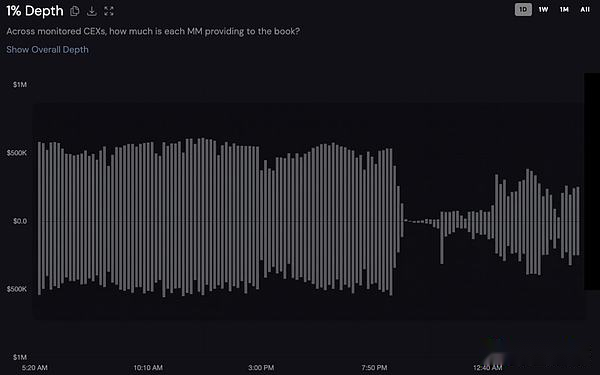
Therefore, it can be inferred that the real situation at that time was: Almost all the MM who were still awake had already begun to foresee the arrival of the storm after 4.40, and wisely withdrew all their orders and left the battlefield in the next 20 minutes.
More MMs formed a stampede and fled in the next 20 minutes. In the panic, almost no one was willing to abide by the MM agreement signed with the project party – the money not to lose money at that time was far greater than the few sweet dates given by the project party.
At that moment,All rational traders are in self-preservation mode – not seeking to make a profit, but only seeking to survive.
In fact, MM who did not get up in time to discover the problem suffered heavy losses in this wave. Many of them found out that they had lost hundreds of millions of dollars after waking up. In the future, 24*7 cross-time zone configuration is likely to become the standard configuration of the MM team.Why was the price difference between Binance and other CEX so big at that time that no one tried to move it?Don’t forget, the liquidity of mainstream CEX is actually provided by the same group of market makers.Wintermute, GSR, Amber, Auros, and Cumberland also make markets on Binance, OKX, Bybit, Coinbase and other platforms.When risks on one of the platforms are severe (for example, Binance futures liquidation surges), market makers will withdraw all exchange pending orders to avoid being implicated in liquidation.So in the few minutes when the market was most chaotic and the price difference between CEX was the largest, the entire market entered a state of liquidity shock. Binance was the main site for recursive liquidation. No one was trying to level the currency price, so wouldn’t the price be the lowest?
~~~~~~~~~~~~~~~~~~
Therefore, the conclusion of my long article is: The current market maker system actually has limitations. When the market is normal, everything operates like a sophisticated machine. But when a black swan appears in the market, it will just compete with retail investors in panic and stampede to see who can flee earlier.
Simply speaking, Binance pulled out the network cable to harvest maliciously. It can only be said that it does not understand the MM system. Binance has a bigger target. Binance is not equal to MM. These are two different things.Of course, what caused the black swan was the structural risk of USDe’s revolving loan, and Binance is responsible for its prevention.However, this plunge did expose many problems, including the market maker MM system that has been operating for many years and seems to be extremely stable. If CEX wants to go further in the future, how to solve this loose cooperation model that can only be defeated is also very important.

